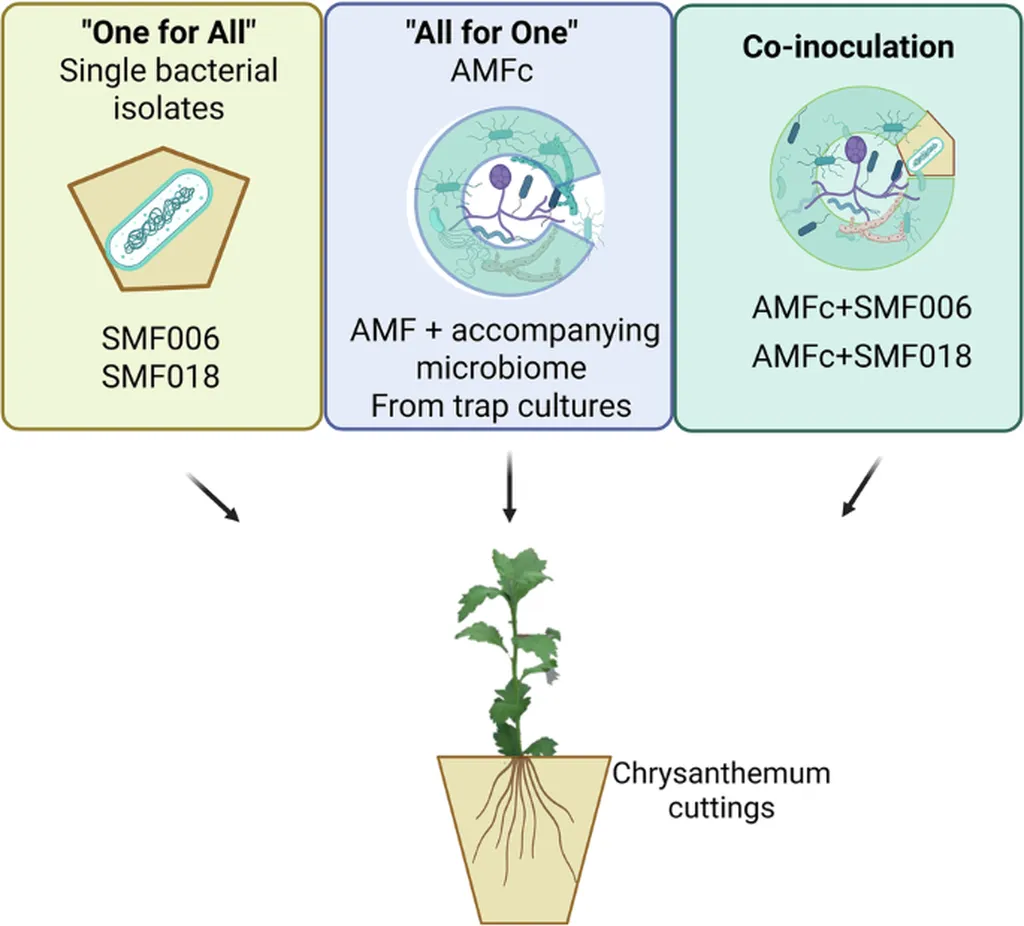In the quest for sustainable agricultural practices, scientists are increasingly turning to nature’s own toolkit: beneficial microbes. A recent study published in *npj Sustainable Agriculture* (translated as *Nature Partner Journal Sustainable Agriculture*) has uncovered a promising synergy between arbuscular mycorrhizal fungi (AMF) and plant growth-promoting bacteria (PGPB) that could revolutionize horticultural production. The research, led by Cristina Rotoni from the Netherlands Institute of Ecology (NIOO-KNAW), demonstrates how these microbial partnerships can enhance root development and shape the rhizosphere microbiome, offering a potent strategy for sustainable crop cultivation.
The study focused on the effects of AMF and their accompanying microbiome (AMFc), derived from a wild chrysanthemum relative, on a commercial chrysanthemum cultivar. Rotoni and her team explored the synergistic effects of combining AMFc with two bacterial strains, SMF006 and SMF018, on plant growth, root architecture, and rhizosphere microbiome dynamics during early development.
The results were striking. AMFc significantly boosted root surface area, diameter, volume, and biomass. When co-inoculated with the SMF006 strain, the root dry biomass increased by an impressive 75%. “This combination not only enhances root development but also shapes the microbial community, enriching beneficial bacteria and fungi,” Rotoni explained. The study identified key beneficial microbes, including Sphingomonas, Taibaiella, Trichoderma, and Penicillium, which thrived in the presence of AMFc and SMF006.
The implications for sustainable horticultural production are substantial. By leveraging these microbial synergies, growers can reduce their reliance on chemical fertilizers and pesticides, promoting healthier plants and more sustainable practices. “This research opens up new avenues for developing bioinoculants that can support plant growth and resilience in a sustainable manner,” Rotoni noted.
The study’s findings suggest that the combination of AMFc and specific bacterial strains like SMF006 could be a game-changer for the horticultural industry. As the demand for sustainable and eco-friendly agricultural practices grows, these microbial partnerships offer a promising solution. The research not only highlights the potential of AMFc and PGPB but also underscores the importance of understanding and harnessing the complex interactions within the plant microbiome.
For the energy sector, which increasingly relies on biofuels and sustainable biomass, this research could pave the way for more efficient and productive crop cultivation. By enhancing root development and plant growth, these microbial strategies can contribute to higher yields and more resilient crops, ultimately supporting the broader goals of sustainable energy production.
As the agricultural industry continues to evolve, the integration of microbial biostimulants like AMFc and PGPB could become a cornerstone of sustainable practices. The study by Rotoni and her team, published in *npj Sustainable Agriculture*, provides a compelling case for the potential of these microbial synergies, offering a glimpse into the future of sustainable horticulture and beyond.

